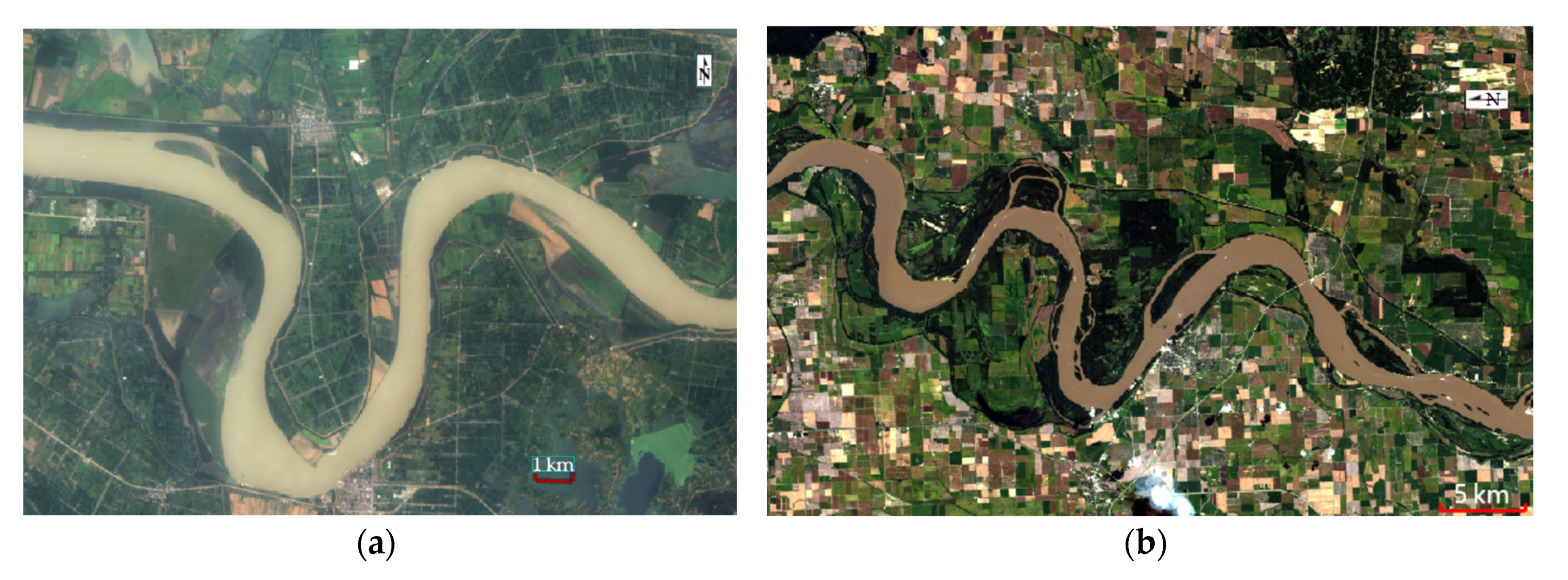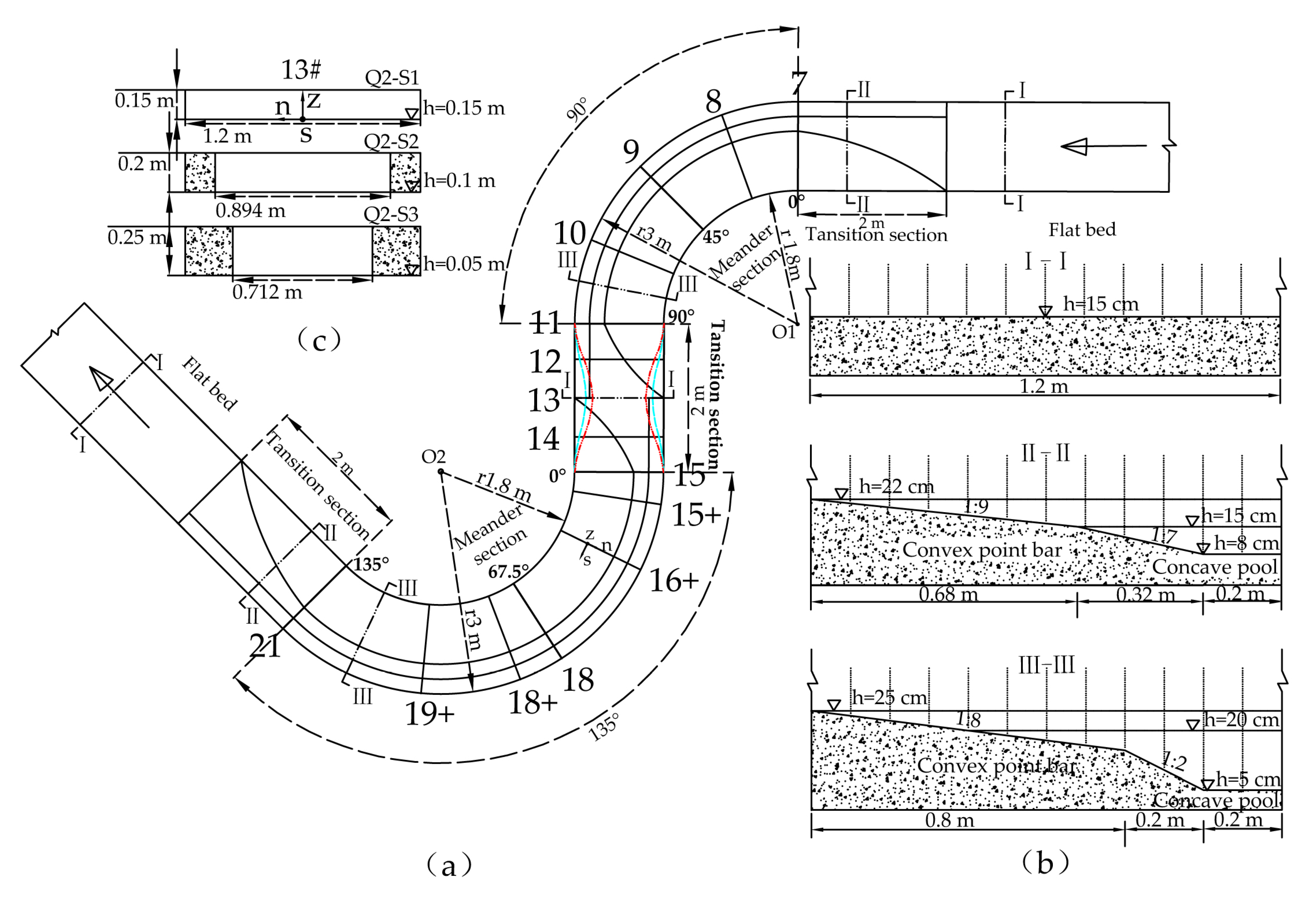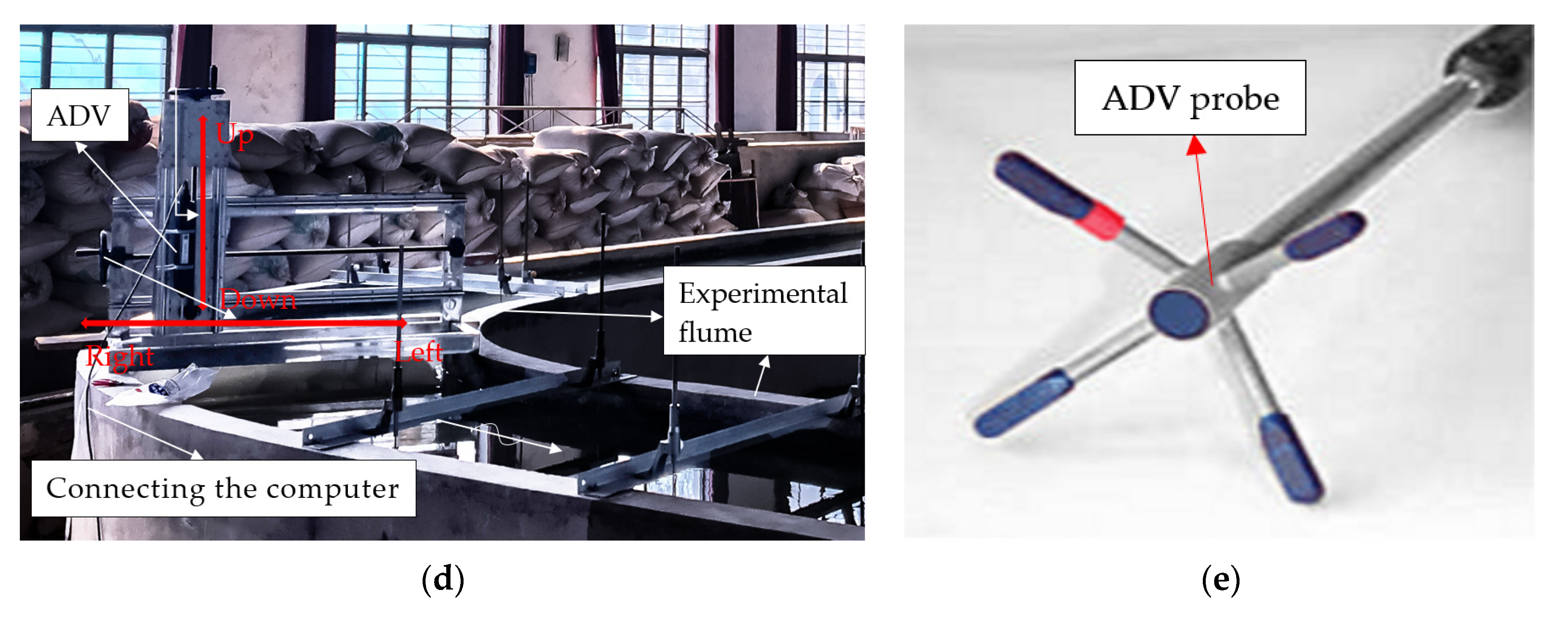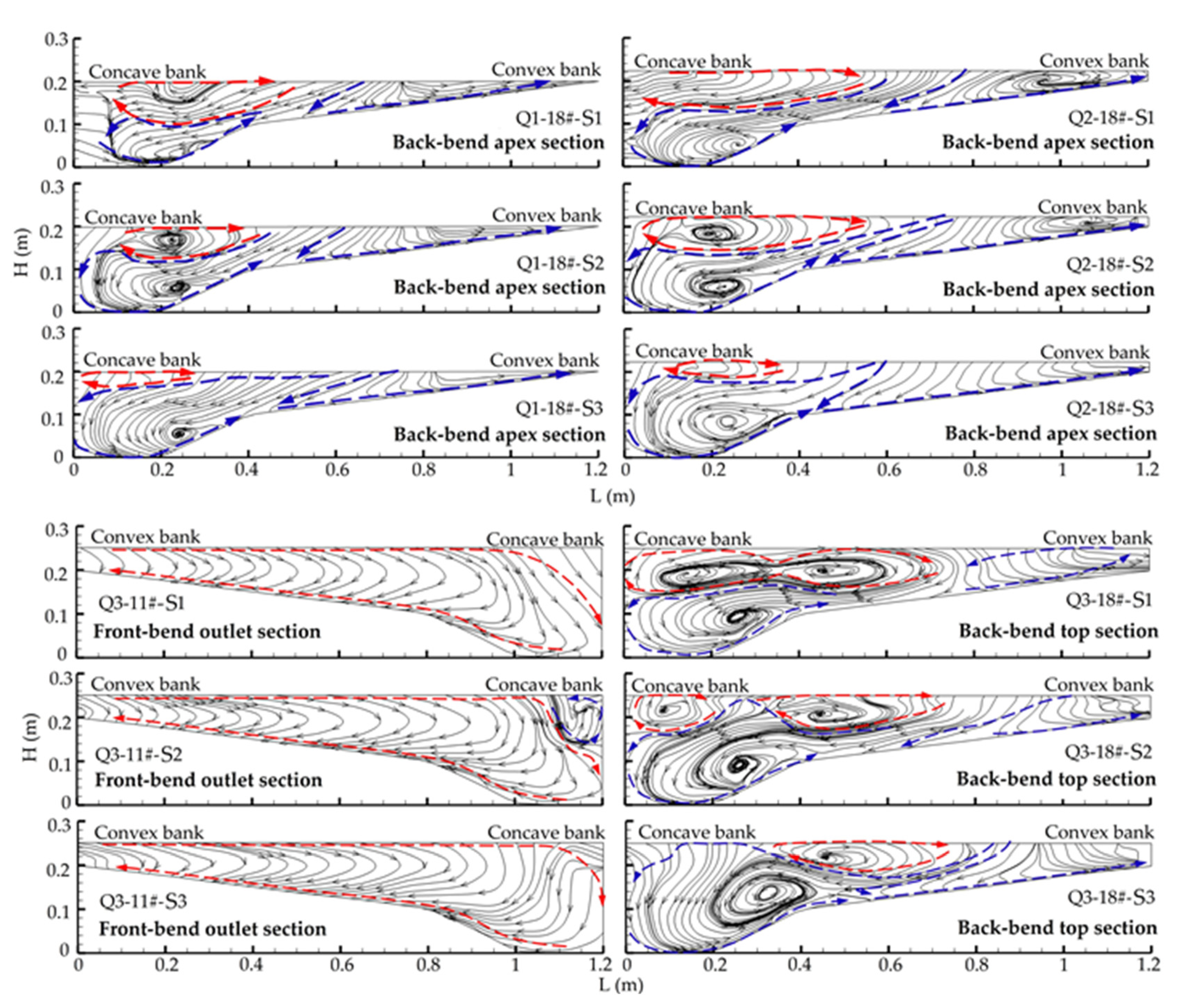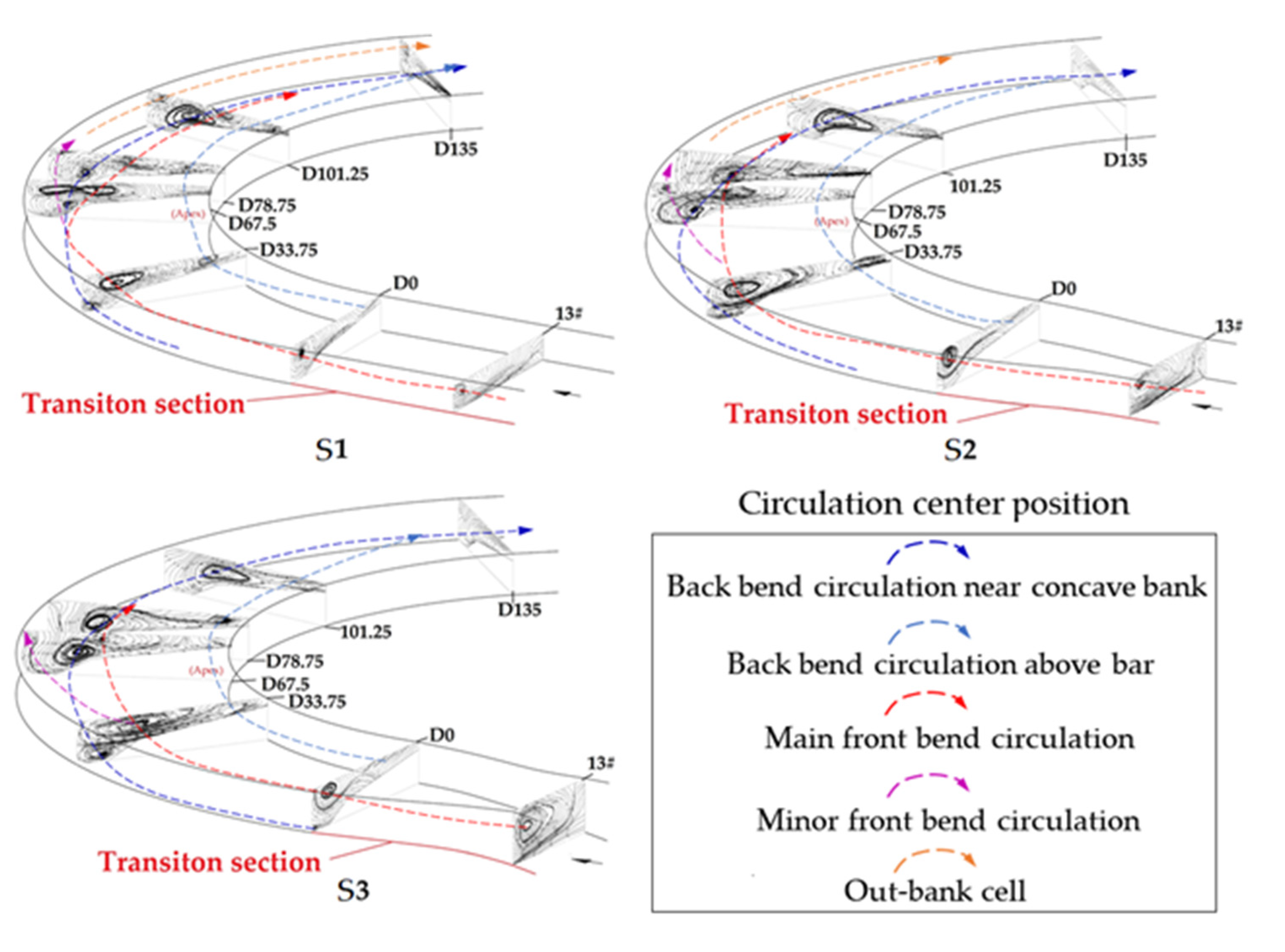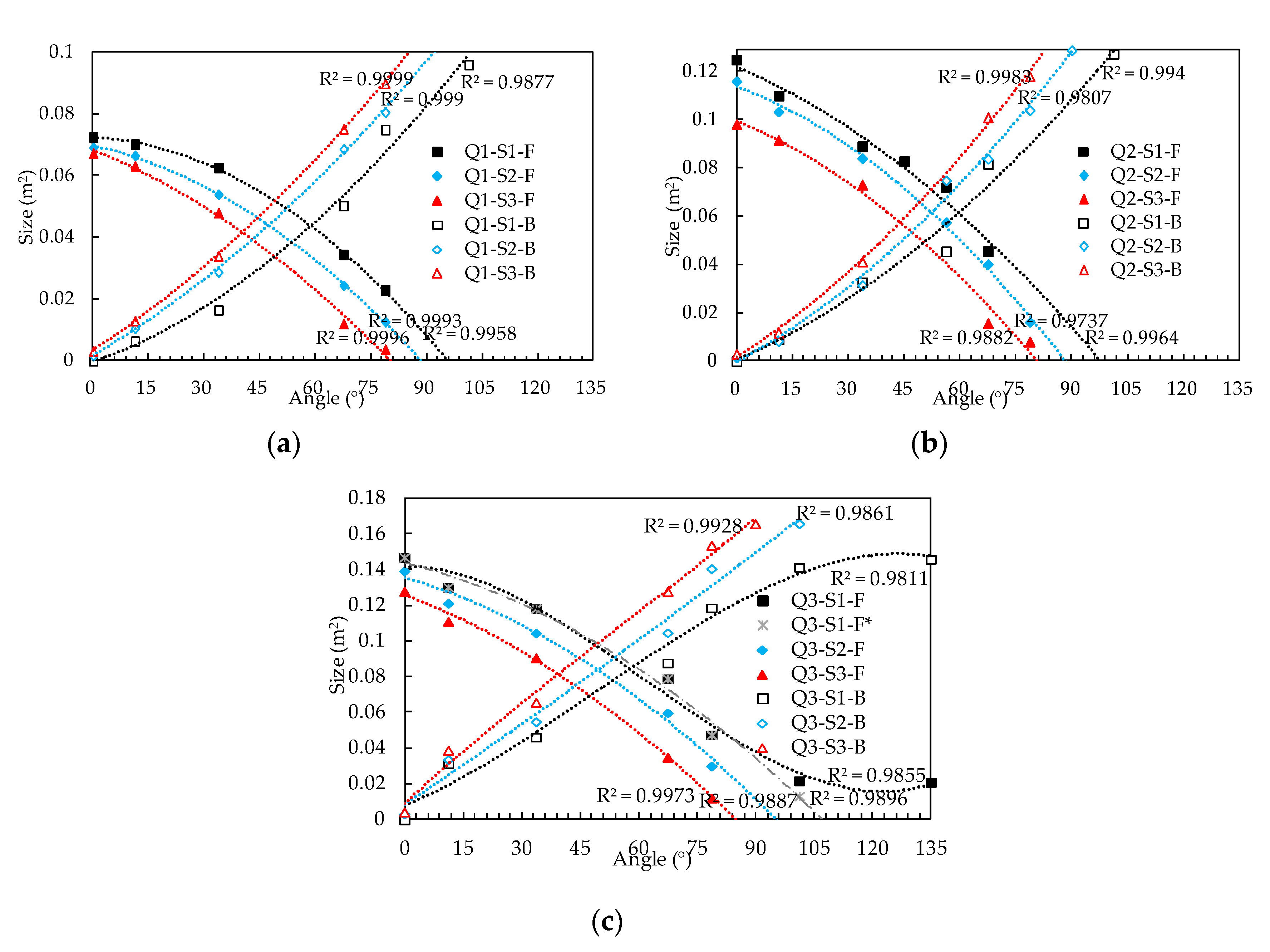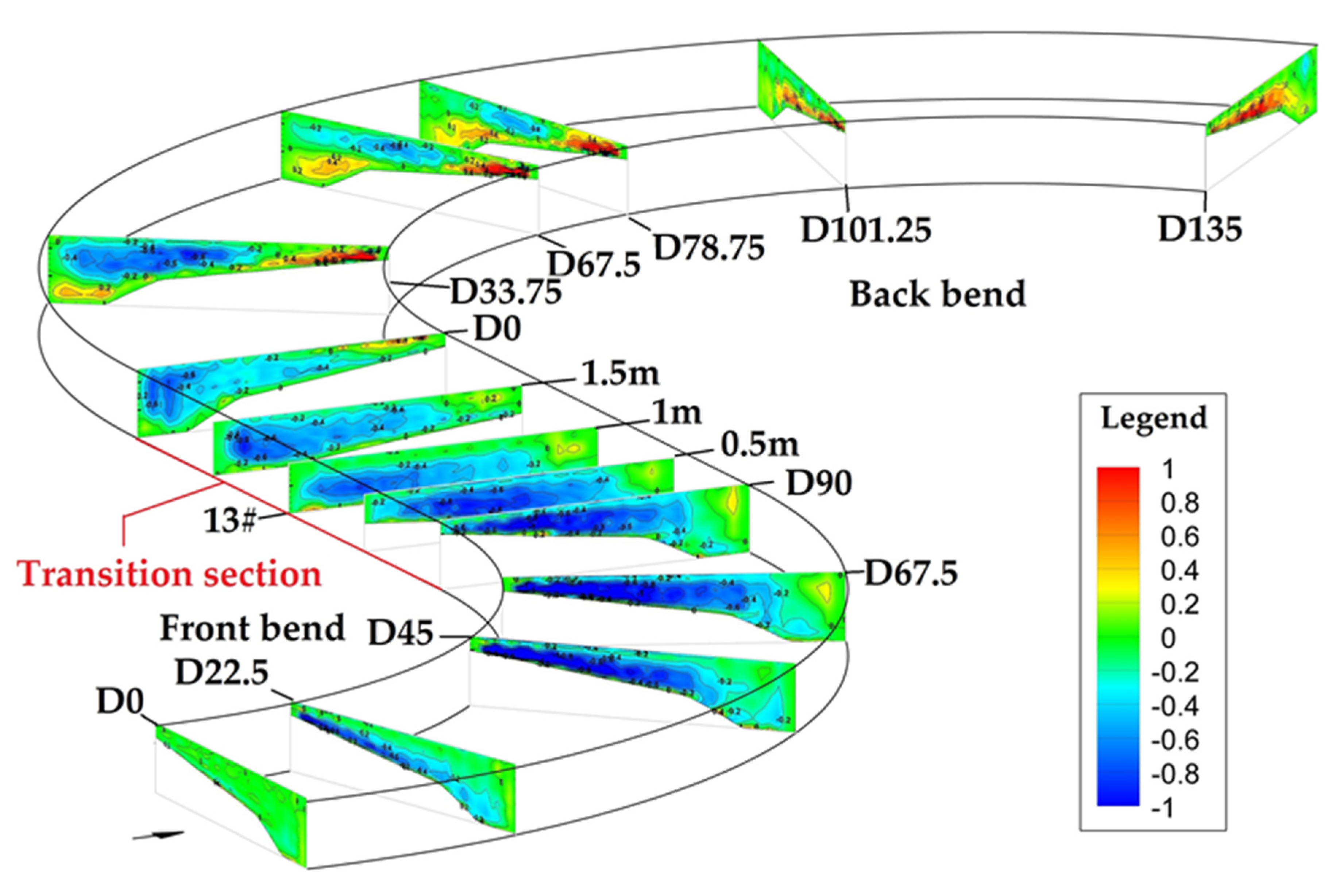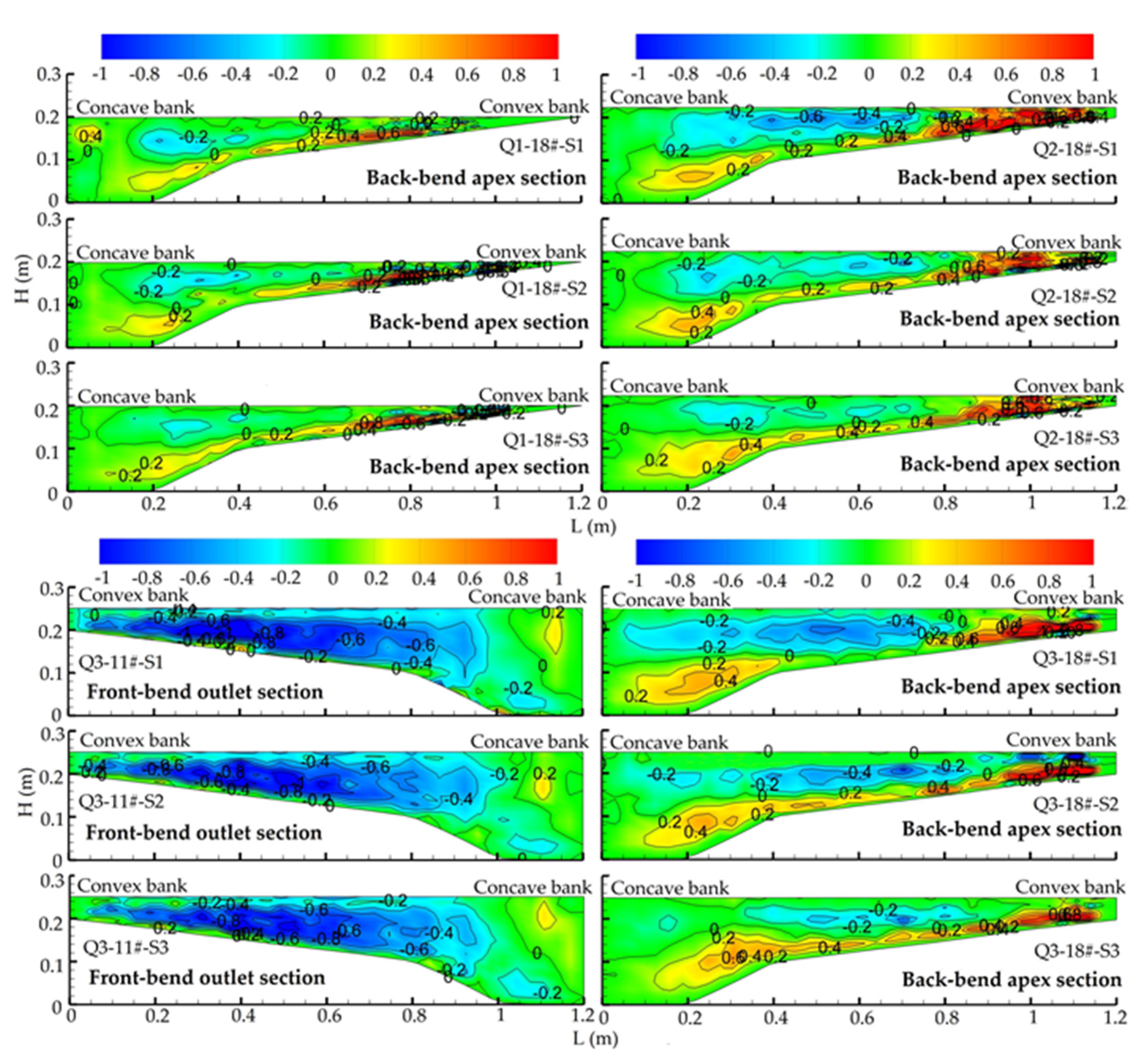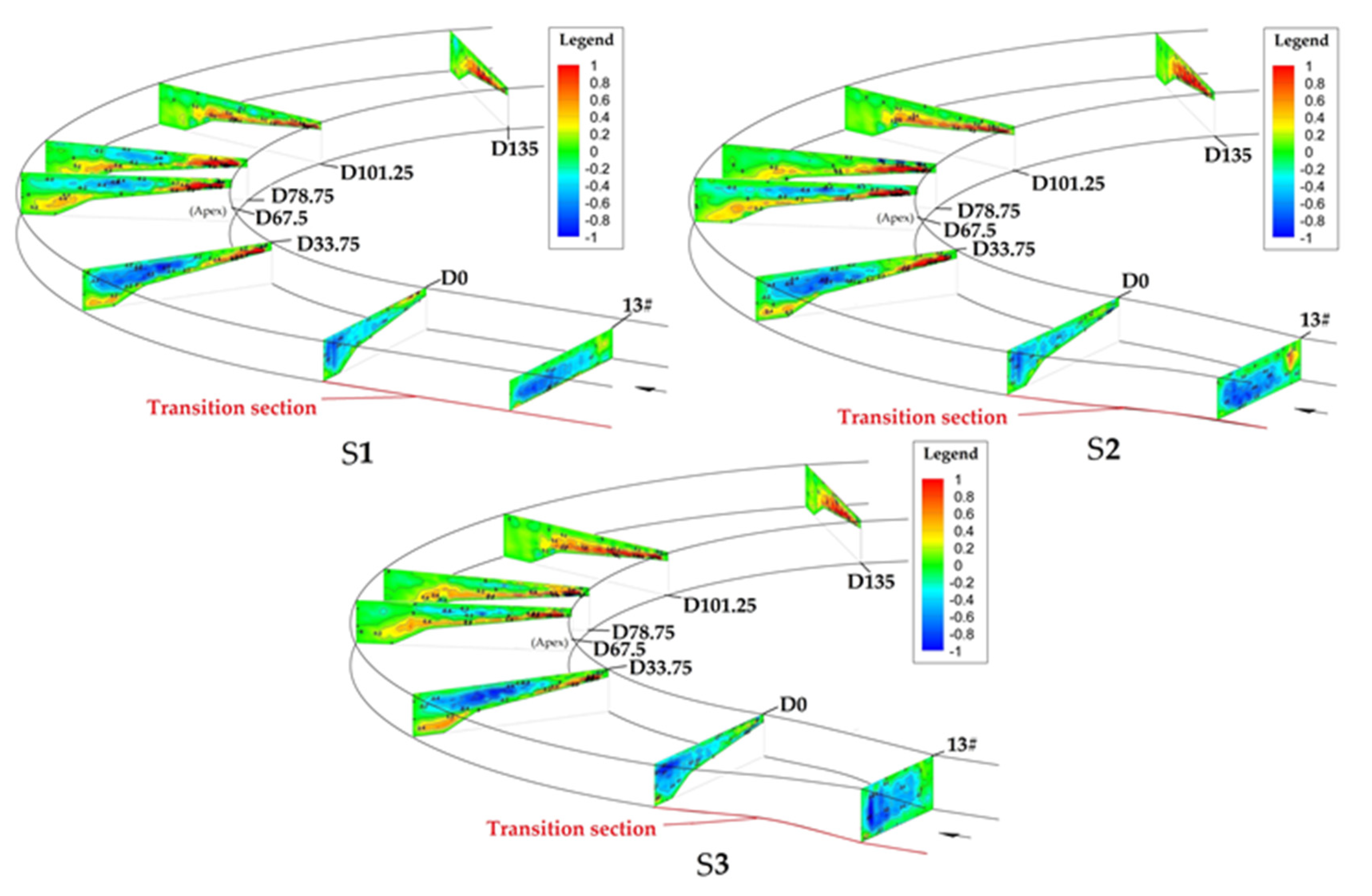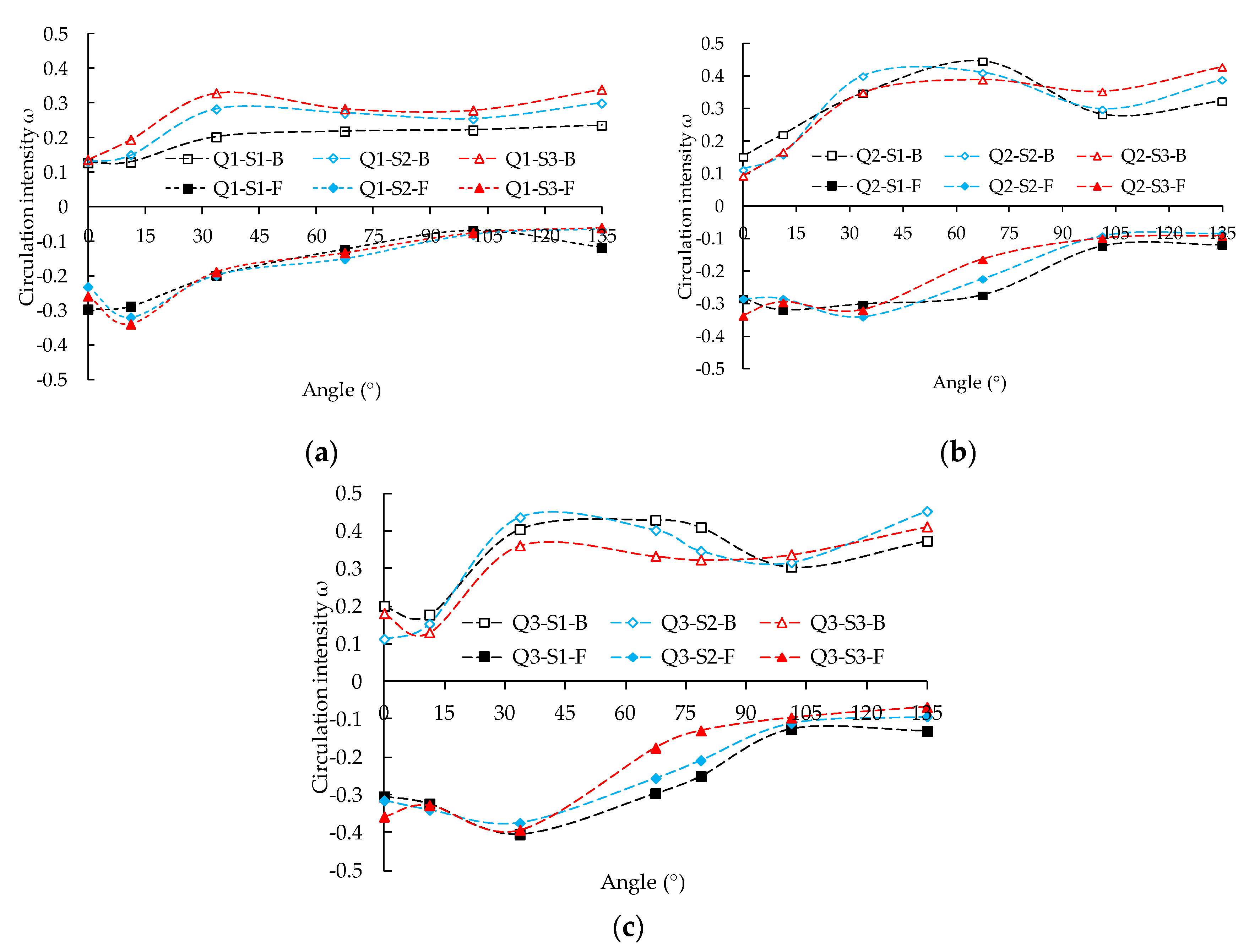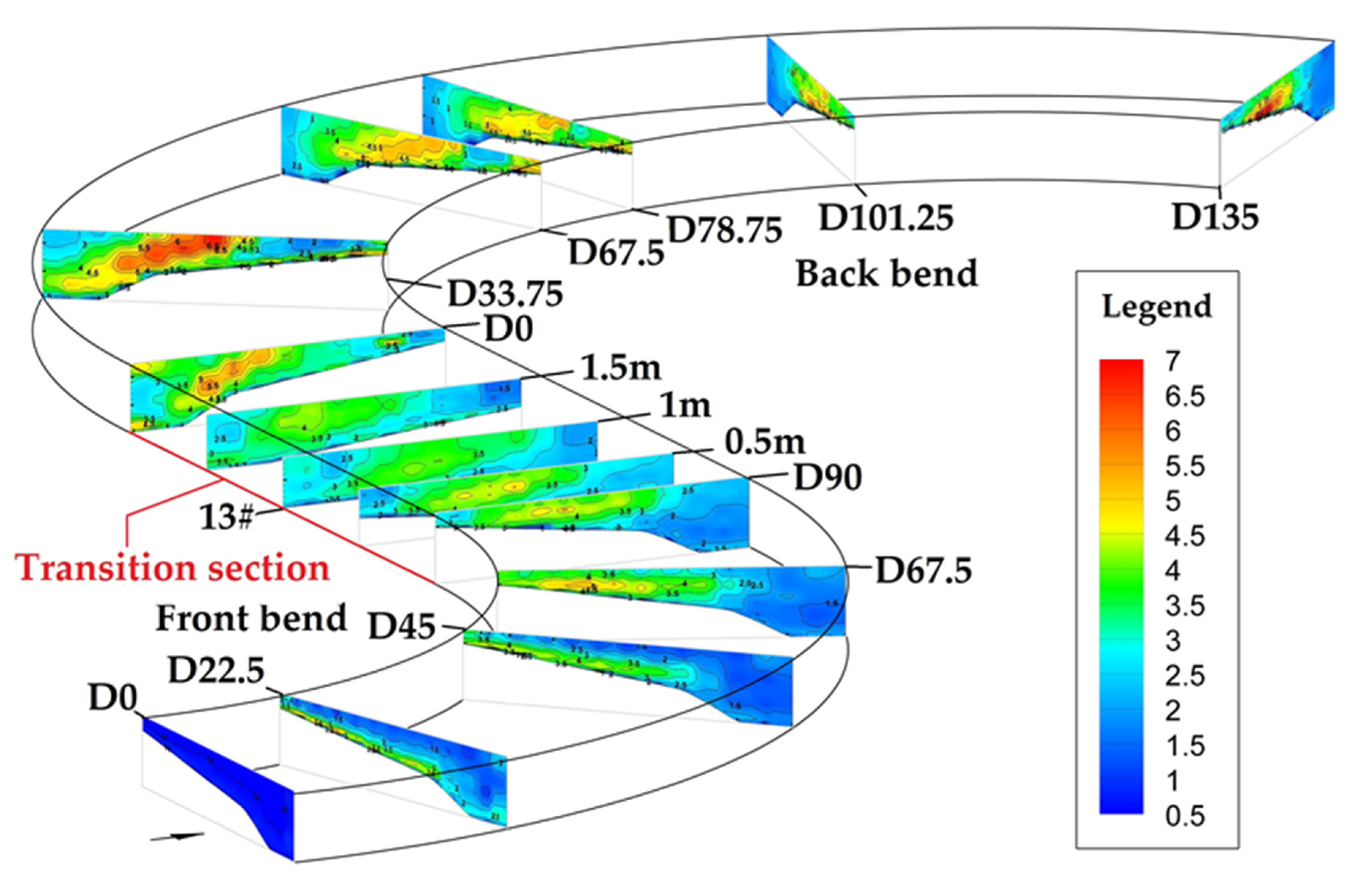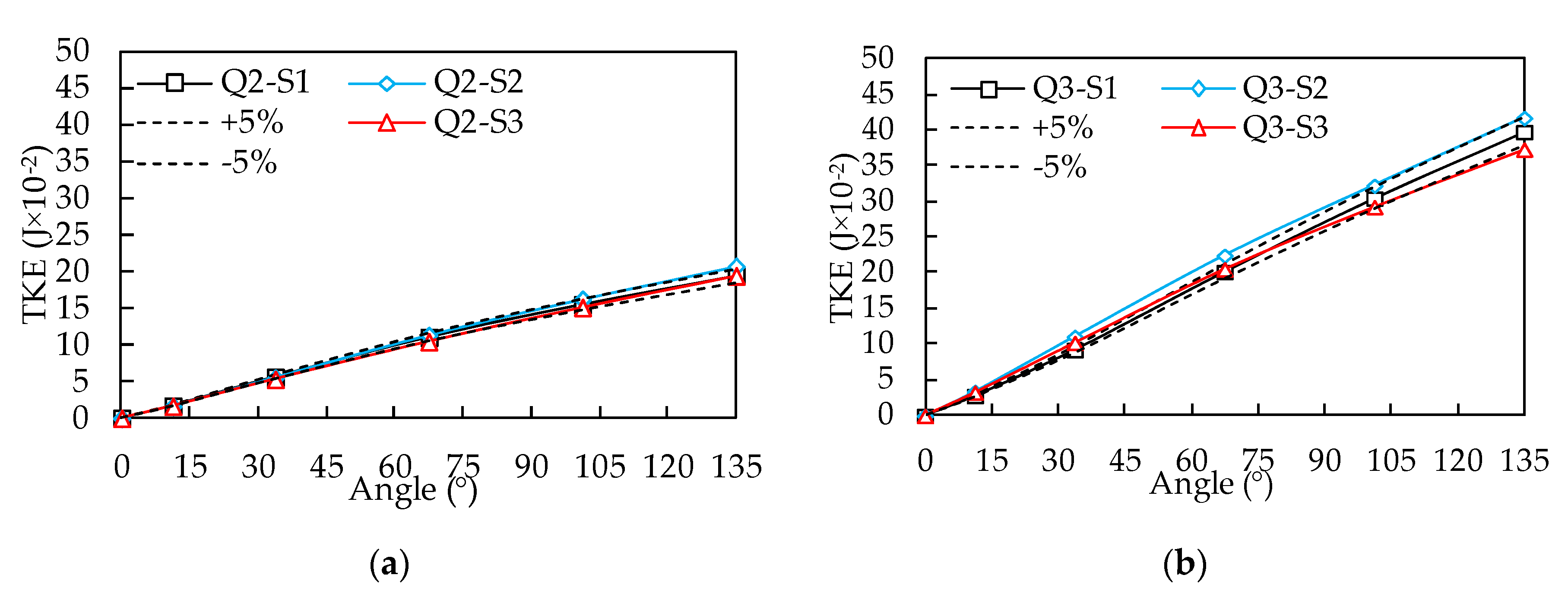3.1. Analysis of the Circulation Structure
In bends, due to the combined action of centrifugal force and hydrostatic pressure, surface water flows to the concave bank, bottom water flows to the convex bank and projection on cross-section forms circulation. In the size of the circulation, the transverse or vertical velocity is always larger than zero.
In typical cross-sections, the time-averaged velocity vector field was synthesized by using the transverse and vertical time-averaged velocities, and the transverse circulation structure was obtained by connecting the vectors with the streamline. The circulation structure here represents the distribution shape and size of the circulation on the n, z coordinate plane. Because the flume adopts a complex cross-section shape that is closer to the actual river channel, the main circulation structure in the bend is mostly narrow, exhibiting an irregular ellipse as the cross-section configuration, which is different from regular rectangular or trapezoidal channels.
Figure 3 is a three-dimensional view of the variation in the circulation structure along the continuous bend at Q3. As shown in
Figure 3, the streamline at the inlet section of the front bend begins to slightly bend, and there are signs of circulation generation. Then, a single clockwise transverse circulation is generated and gradually developed along the channel. At the outlet section, the circulation structure occupies the whole section. It can be seen from the red dotted line of the circulation centre position, the circulation centre gradually shifts from the bottom to the middle of the water body. In the transition section, we also observe a single clockwise circulation structure; however, the size is reduced, and the circulation centre is located closer to the left bank.
In the back bend channel, a single clockwise circulation can be seen at the inlet section. Since transverse circulation cannot be produced without centrifugal force, the clockwise circulation structure at the transition section and the inlet section are all the RCFB. The size of the RCFB decreases gradually along the channel, and the circulation structure is divided into two parts at the apex of the bend: the part moving to the surface of the concave bank and the part moving to the centre of the river channel. The RCFB near the concave bank is consumed by the Circulation of the Back Bend (CBB), approaching complete attenuation near 78.75° (purple dotted line), while the RCFB in the central area exists until close to the outlet of the back bend (red and orange dotted line). It should be noted that the very weak clockwise circulation structure near the concave bank gradually increases. Fariba and Alireza [
28] found that the centrifugal force and cross-stream turbulent shear stress are main driving forces of near bank circulations and such conditions do exist near the concave bank. Combining the observed changes in the circulation structure along the channel, it can be inferred that this circulation is an “out-bank cell” (orange dotted line). After entering the back bend, an anticlockwise circulation structure begins to form near the bed of the concave bank (dark blue dotted line), and then an anticlockwise circulation structure forms above the convex point bar (blue dotted line). Along the channel, the two CBBs develop gradually, with the circulation in the concave pool being dominant. Afterwards, the two CBBs gradually merge together. In the back bend, a single circulation model is no longer applicable; two or more circulation structures with different vortex directions coexist, and the circulations in different directions squeeze each other, resulting in an irregular circulation structure.
Typical sections are selected to analyse the influence of changes in the width/depth ratio on the circulation structure under different scenarios and discharges. As shown in
Figure 4, with the decrease in the width/depth ratio of the transition section, at Q3, the circulation structure in the outlet section of the front bend changes little and is only slightly different in the upper part of the water body near the concave bank. However, at the three discharges, the circulation structure distribution at the apex section of the back bend all changes greatly. Especially at Q3, the size of the clockwise circulation structure decreases gradually and is divided into two parts, the component on the concave bank side gradually disappears; the size of the counterclockwise circulation structure gradually increases, and the two circulations gradually approach each other, nearly merging at S3. At other discharges, the RCFB at the apex section of the back bend decreases gradually, the CBB increases gradually.
To understand the change in the structure of the back bend more clearly, circulation structure distribution at typical cross-sections along the back bend in different scenarios is shown in
Figure 5. Two or more circulation structures with different vortex directions coexist along the back bend in different scenarios. With the decrease in the width/depth ratio of the transition section, the size of the RCFB decreases gradually at the same cross-section, and minor RCFB rarely exists at cross-section 67.5° and either as main RCFB at cross-section 78.75° in S3. Meanwhile, the size of the CBB increased gradually at the same cross-section, and an anticlockwise circulation appears at the inlet section of the back bend at S3. There are no clockwise circulations near concave bank water surface at S2 and S3.
The changes in the size of the two kinds of circulation structures along the channel are analysed for different discharges and different scenarios (the CBB includes two parts, one in the concave pool and another above the convex point bar). To perform a more accurate statistical analysis of the circulation structure size, a cross-section is divided into grids with a maximum spacing of 1 cm. After interpolation, velocity vectors are plotted in each grid to identify the range of circulation. The statistical size is the size within the outer contour of the cross-section circulation; if the grid is within the range of circulation, its size is added to the circulation structure size. The changes in the size of the two kinds of circulation structures along the channel are plotted, and then, the trend lines are fitted, as shown in
Figure 6. The location information of the key changes in the two circulation structures are given in
Table 3.
As shown in
Figure 6 and
Table 3, at Q3~S1, the size of the structure of the RCFB in the back bend decreases gradually along the channel, while the size of the CBB increases. The size of the two kinds of circulation structures has the same intensity at approximately 59°. The trend near the outlet of the back bend has a large variation amplitude, which is mainly influenced by the abovementioned “out-bank cell”. The grey dotted line in the figure is the trend line after removing the “out-bank cell”. According to its intersection with the abscissa, the position corresponding to the complete attenuation of the RCFB can be deduced. The change in the circulation structure size at other discharges are similar to that of Q3, which also shows that the size of the two kinds of circulation structures increases and decreases along the channel, respectively, but there is no “out-bank cell” near the back bend outlet, and the trend is clearer. The positions where the intensities of the two circulation structures are equal are slightly different at different discharges (see
Figure 6a,b).
It can be seen that the size of the two kinds of circulation structures varied with width/depth ratio of the transition section, under different conditions with the same discharge. The size of the RCFB decreases considerably at the inlet section of the back bend and then decreases downstream at the same position, and the complete attenuation position of the RCFB advances gradually. The generation position of the CBB also advances gradually with increasing size. The position where the intensities of the two circulation structures are equivalent clearly advances with decreasing width/depth ratio (see
Table 3).
3.2. Analysis of Circulation Intensity
To quantitatively analyse the variation in the circulation on the typical section in the continuous bend, the intensity of the circulation is calculated. In this paper, circulation is regarded as the current rotating around a central point, and vorticity is used as an index to measure the circulation intensity. The vorticity field (three vorticity components) is determined based on the velocity flow field; the calculation formula is as follows [
29,
30,
31,
32]:
where
is vorticity in downstream direction,
and
are the transverse and vertical components of velocity. After dimensionless treatment,
, the contour map of the circulation intensity distribution in a typical section of a continuous bend was drawn, in which a negative value represents clockwise circulation, a positive value represents anticlockwise circulation, and the 0 contour line represents the boundary line between the two kinds of circulations, which is used to analyse the change in the distribution size of the two kinds of circulations.
Figure 7 shows a three-dimensional view of the distribution of circulation intensity along the continuous bend with Q3. Combined with the analysis of circulation structure, this figure shows that clockwise circulation gradually occurs in the front bend, and the circulation intensity and size increase gradually along the channel, reaching a maximum value near 67.5°; there is no obvious decline in the circulation intensity until the exit of the bend. A small area of positive values appears near the concave bank of the front bend exit, which may indicate the formation of the “out-bank cell”, but no circulation structure is formed (see
Figure 4). In the transition section, the clockwise circulation is still easily observable, but the intensity, especially the strong circulation intensity, decreases greatly (
> 0.6).
The size of the clockwise circulation at the inlet section of the back bend is still large, almost occupying the whole section. Although the size of the weak circulation intensity decreases to some extent, the size of the strong circulation intensity increases considerably at the 33.75° section, and the overall circulation intensity increases. The strong and weak circulation intensities both decrease rapidly below this section. Although there is sign of anticlockwise circulation at the bottom of the concave pool at the inlet section of the back bend, the formation of the anticlockwise circulation structure does not begin until the section of 11.25° (15+#), after which it develops gradually along the channel, and the intensity and size of the circulation increase gradually. After that, the two anticlockwise circulations merge together, and the circulation intensity centre moves to the middle of the channel.
The sections of the front bend outlet and back bend apex were selected to analyse the variation in circulation intensity at the same time under different scenarios and different discharges. As shown in
Figure 8, at Q3 and all three scenarios, the circulation intensity at the outlet section of the front bend weakens slightly, and the left and right sides of the main circulation area reduce slightly, but the overall change is not obvious; however, the circulation intensity and size at the apex section of the back bend change more obviously. With the decrease in the width/depth ratio of the transition section, the clockwise circulation intensity and size gradually decrease, while the counterclockwise circulation intensity and size gradually increase correspondingly. At other discharges, there is an obvious RCFB in the back bend, and the intensity of the CBB is influenced by the front bend; with the decrease in the width/depth ratio of the transition section, the change laws are the same as Q3.
To show the variation in the circulation intensity of the back bend more clearly, circulation intensity distribution of typical cross-sections along the back bend at different scenarios under typical discharge is given in
Figure 9. As figure shows, in different scenarios, two kinds of circulation intensity coexist. With the decrease in the width/depth ratio of the transition section, before the cross-section 33.75°, the intensity of the RCFB increases gradually at the same cross-section; then, after this section, all decrease rapidly. A positive intensity circulation appears at the inlet section of the back bend at S3. There are no negative intensity circulations near concave bank water surface at S2 and S3.
Figure 10 shows the variation in the two circulation intensities along the back bend for different discharges and scenarios. At Q3~S1, the intensity of the RCFB increases slightly near the entrance of the back bend and then decreases, with a small amplitude of fluctuation; however, the intensity of the CBB increases abruptly near the entrance and then changes slowly, weakening near the exit of the back bend, with a larger amplitude of fluctuation. The variation in circulation intensity at Q2~S1 is similar to that at Q3, but the variation in the intensity of the RCFB in the forward half of the back bend is not obvious, while at Q1~S1, the intensity of the RCFB is mainly reduced, and the intensity of the CBB mainly increases without fluctuating.
For the same discharge, with the decrease in the width/depth ratio of the transition section, the results of Q2 and Q3 show that the intensity of the RCFB weakens; while the intensity of the CBB changes only slightly, its fluctuation amplitude decreases greatly. In Q1, the intensity of the RCFB changes little, but the intensity of the CBB increases gradually.
At a fixed width/depth ratio, with increasing discharge, the intensity of the RCFB in the back bend gradually increases. The fluctuation of turbulence intensity in the back bend increases, with the distribution becoming more complex.
3.3. Analysis of Turbulent Kinetic Energy
Turbulent kinetic energy is a physical quantity that characterizes the degree of fluid turbulence. The magnitude of turbulent kinetic energy can reflect the intensity of fluid turbulence, the degree of fluid collision and friction. To calculate the TKE of each typical section along the continuous bend, the following calculation formula is employed:
where
,
and
are the longitudinal, transverse and vertical turbulence velocity, respectively;
,
and
are the longitudinal, transverse and vertical average turbulence intensity, respectively. The TKE distribution diagram of the typical sections along the continuous bend at Q3 is drawn in
Figure 11.
As shown in
Figure 11, the TKE in the front bend is divided into two parts, namely, the high-TKE area (6 > k ≥ 4.5) and the low-TKE area (k < 4.5). The results show that the TKE at the inlet section of the front bend is low and then increases gradually along the channel, with the area of high TKE appearing gradually. The high TKE reaches a maximum near 67.5° and then decreases slightly, while the low TKE increases along the channel. In the transition section, the high TKE disappears, and the low TKE increases slightly.
The amplitude of the variation in the distribution of the TKE in the back bend is larger than that in the front bend, with a very high TKE (k ≥ 6). In the middle part of the flume (0.2–0.9 m), the area of high TKE appears in the upper part of the middle part of the flume at the inlet section, and the overall TKE is relatively high. After that, the TKE in this part of the water body increases greatly, reaching a very high TKE, and then decreases gradually until the areas of very high TKE and high TKE disappear. Correspondingly, the TKE increases gradually in the concave pool; the high-TKE area forms and expands gradually in the lower part of the water body, gradually approaches the middle part of the flume, and remains close to the bed surface. At the same time, with the increase in the TKE, the area of very high TKE slowly forms and then occupies the dominant position. With the area of very high TKE approaching the middle of the flume, the TKE in the concave pool decreases greatly.
As shown in
Figure 12, at three scenarios, the high TKE enters the transition section with the flow after exiting the front bend; although the high TKE decreases along the channel, the flow into the back bend still carries a high residual TKE, and after entering the back bend, it experiences rapidly increases. After that, the residual TKE of the front bend begins to be consumed, the back bend begins to produce TKE, which gradually develops along the channel, and the phenomenon of double peaks coexisting in the middle and back reaches of the back bend arises. With the decrease in the width/depth ratio of the transition section, before the cross-section 33.75°, the TKE all increases relative to S1 at the same cross-section; then after this section, the TKE in the concave pool decreases gradually along the way, but the TKE above the convex point bar decreases firstly gradually and then increases relative to S1 at the same cross-section.
Figure 12 shows that the TKE distribution of the back bend is more complex. It is not easy to distinguish the residual TKE of the front bend from that generated by the back bend, and because the TKE is a field concept and a single section is not representative, the total TKE of the whole water body in the back bend is calculated. As shown in
Figure 13, according to the change in the total TKE slope along the back bend, at the same discharge, with different width/depth ratios of the transition section, the distribution of the TKE along the back bend water body changes, but the overall change is small. The total TKE shows the same law, increasing slightly at S2 and decreasing slightly at S3, but the overall change is small, with a variation amplitude of approximately 5%. Comparing the results of different discharges under the same conditions, it is found that the greater the discharge is, the greater the amplitude of the variation in the TKE distribution, and the greater the total TKE.
3.4. Discussion
In this paper, the correlation between the front and back bends of a continuous bend is mainly revealed by their interaction. However, the analysis of the circulation structure, intensity and distribution of TKE along the continuous bend shows that the influence of the back bend on the front bend is relatively small and not easy to reflect [
33], so it is usually not the focus of attention. Moreover, van der Meer et al. [
34] and Lanzoni and Seminara [
35] have shown that for an open channel with B/H < 10, the influence of a change in the downstream riverbed morphology will not extend upstream; the B/H ratios corresponding to all the scenarios in this paper are less than 10. Therefore, this paper mainly discusses the influence of the front bend on the back bend and the correlation reflected from this and explores the influence of the width/depth ratio of the transition section on the correlation between the front and back bends. Here, the correlation characterizes the degree of the influence of the front bend on the back bend, including the influence on circulation structure, circulation intensity and TKE. The greater the degree of influence, the stronger the correlation.
As the results show, when comparing the circulation structures of the front and back bends, there is only one single clockwise circulation in the front bend, and the configuration of the circulation structure is relatively regular. However, in the back bend, two or more circulation structures with different vortex directions coexist, with irregular circulation structure, which is similar to the previous results [
22,
36]; the circulation structure in the back bend is clearly more complex. The same as the circulation structure, the circulation intensity in the back bend is also clearly more complex. If the back bend is not influenced by the front bend, the evolution law of the circulation intensity of the back bend should be similar to that of the front bend and close to the maximum value near 67.5°. However, the development of the CBB is obviously restrained by the front bend, and the circulation intensity does not reach the maximum value, even at the outlet of the back bend. At the same time, the overall TKE along the back bend is larger, the areas of high TKE and very high TKE are clearly formed, the very high TKE region alternates along the channel, and the TKE distribution in the water body is more complex. The main reason for this phenomenon is the existence of residual TKE carried by the flow into the back bend.
Thus, it can be seen that due to the existence of the front bend and the short length of the transition section, the flow in the back bend carries the RCFB and TKE, which makes the distribution of the circulation structure, intensity and TKE of the back bend more complex, and makes the circulation intensity of the CBB smaller and total TKE greater than that of the front bend (single bend). It can be seen that the presence of the front bend will change the flow characteristics of the back bend. This finding is consistent with the results of Xiao et al. [
37] and Moncho-Esteve et al. [
38]. In addition to the circulation structure and intensity, it can also be seen that there is a strong correlation of the TKE between the front and back bends of the continuous bend.
Comparing different discharges under the same scenarios, it can be seen that with the increase in the discharge, the complete attenuation position of the RCFB gradually moves backwards. The distance of the influence of the front bend on the back bend increases. The intensity of the RCFB in the back bend gradually increases, with the distribution becoming more complex. The greater the amplitude of the variation in the TKE distribution is, the stronger the correlation becomes.
At Q3-S1, the structure of RCFB is continuously consumed when it passes through the transition section and enters the back bend, which is similar to the results of Bryk [
25]. Previous studies have indicated that it takes a long distance for the circulation out of the front bend to completely disappear [
39,
40]. In this study, the complete attenuation position is at approximately 108°. However, according to the decline formula of the out-of-bend circulation presented in previous studies [
39], the calculated decay distance is far beyond this length. The main reason for this finding is that the generation of the CBB and the opposite riverbed topography accelerate the decline in the RCFB. It can be seen that the circulations with the opposite vortex directions consume each other in the back bend. However, due to continuous power input, the CBB develops gradually, so the sizes of the two kinds of circulations show decreasing and increasing trends, respectively. The size and intensity of the RCFB decreases gradually, while those of the CBB increases gradually. The intensities of the two kinds of circulations are equivalent at approximately 60°. However, Rui [
41] found that the intensities of these two kinds of circulations are equivalent at the outlet of the back bend (90°); the above difference is mainly due to the influence of the transition section, which weakens the front-bend factor before entering the back bend.
As the results shown, the intensity of the RCFB and the TKE all increase firstly (before 33.75°) in the inlet reach of the back bend, then decrease after 33.75°. Termini and Piraino [
42] also found that the intensity of the RCFB increases firstly, then it decreases in intensity and disappears at crossover-section downstream, but it increases before the bend apex. However, Abad and Garcia [
7,
9] found that the intensity of the RCFB keeps increasing.
Combined with the change in circulation structure and intensity, it is found that the change in the TKE is consistent with that of the circulation structure and intensity along the channel, with each high-TKE region corresponding to a region with a strong circulation intensity. There is a single circulation structure in the front bend, whose intensity increases first and then decreases. Same to this study, Shukry [
43], Kashyap et al. [
44], Bai et al. [
45] and Vaghefi et al. [
46] all found that the intensity of the circulation increases gradually along the channel, reaching a maximum value at approximately 70°; there is no obvious decline in the circulation intensity until the exit of the bend. Correspondingly, the TKE also exhibits a single peak with similar trends, and even at the same place. The alternation of high-TKE regions in the back bend channel corresponds to the transformation of the primary and secondary positions of the RCFB and CBB. Thus, the size and distribution of the TKE are closely related to the size and distribution of the circulation intensity and circulation structure [
47]. Moreover, the structural size, intensity and TKE of the RCFB all shrink to some extent after passing through the transition section, while all of them show expansion trends after entering the back bend. The synchronous trends of the convergence and expansion of structure size, intensity and TKE can also prove the above viewpoint. As shown in the results, with the decrease in the width/depth ratio of the transition section, at all discharges, the size of the RCFB decreases gradually, whereas the size of the CBB increases gradually due to the weakening of the inhibition effect, and the complexity of the distribution of the circulation structure in the back bend decreases; meanwhile, the intensity of the RCFB in the back bend decreases considerably; the complexity of the flow characteristics of the back bend decreases considerably, and the correlation between the front and back bends weakens. By measurement data analysis, You et al. [
48] found that barrier reaches with low width/depth ratio can block the upstream channel adjustment from propagating to the downstream reaches in the bifurcated river. You’s results indicate that transition sections with low width/depth ratio have barrier effect and can decrease correlation between upstream and downstream reaches, which is in accordance with our results.
However, with the decrease in the width/depth ratio of the transition section, the circulation intensity above the convex point bar of the back bend does not become stronger but weakens gradually. The above phenomena are mainly due to the weakening of the inhibition of the RCFB. The compression effect on the circulation above the convex point bar is weakened accordingly and then extends to the middle of the river channel, so the corresponding vortex rotation degree weakens, which reflects that the circulation intensity decreases. The inhibition of the RCFB in the back bend gradually weakens, the intensity of the CBB also gradually weakens, which is partly due to the change in circulation size, and the overall fluctuation decreases, which indicates that the influence of the front bend gradually weakens. However, Q1 is different from Q2 and Q3: The intensity of the CBB increases gradually, but the variation in the RCFB is small, mainly because the circulation structure does not occupy the whole water body, and the RCFB easily moves; back-circulation develops relatively easily.
With the decrease in the width/depth ratio of the transition section, the intensity of the RCFB that enters the back bend, decreases. The main reason for this is that after decreasing the width/depth ratio of the transition section, the TKE of the water body increases, which leads to an increase in the water mixing level, leading to the energy consumption of the water body. At the same time, a change in the width/depth ratio will cause the river resistance to vary [
49,
50]. Above a certain width/depth ratio, with decreasing width/depth ratio, the river resistance increases. Under a certain width/depth ratio, although the resistance is not directly affected by the width/depth ratio, the effect of the sidewall becomes larger, and river resistance will also increase [
51]. Moreover, in order to reduce the abrupt change in the boundary, the channel shape with a gradual change in river width is adopted; this kind of channel shape will change the flow and turbulence structure, which will directly lead to the direction of flow in a gradually shrinking reach to deviate from the sidewall to the axis and then in a gradually expanding reach to deviate from the axis to the sidewall. The aggregation and diffusion of the streamline increases the mixing level of the water body to some extent, which increases the water energy quantity loss. At the same time, anticlockwise circulation will be produced in the gradually expanding reach [
52], which will also increase the consumption of the clockwise circulation of the front bend to some extent.
With the decrease in the width/depth ratio of the transition section, the total TKE in the back bend water body remains almost unchanged. The reason for this may be that when the configuration of the transition section changes, the flow mixing increases, leading to the increasing consumption of the forward bend circulation and increase in the converted TKE, so the TKE near the entrance of the back bend increases. The change in TKE is mainly concentrated in the second half of the transition section [
53], and the change in TKE gradually highlights after entering the back bend; therefore, the difference in total TKE entering the back bend for the three scenarios is minor. Only with the decrease in the width/depth ratio of the transition section, part of the energy is carried by the RCFB that is converted into TKE in advance. Moreover, this study shows that the weakening of the RCFB corresponds to the enhancement of the CBB, so the corresponding TKE of the CBB is also slightly increased, which can reduce the difference caused by TKE loss in the transition section observed under all three scenarios. Therefore, the total TKE of the back bend water body does not change significantly with the change in the width/depth ratio of the transition section.
As mentioned above, the correlation is reflected by the influence of the front bend on the back bend, including the influence on the distribution of circulation structure, circulation intensity and TKE, number of the circulation and so on. However, all of these phenomena are due to the direct influence of the RCFB existence; thus, the distance that the RCFB exists in the back bend directly determines the degree of influence, that is, the correlation (see
Table 3). The ratio of the existing distance of RCFB in back bend to the length of the back bend is used as a measure of the correlation and as a quantitative indicator of the correlation. The longer the distance of the RCFB in the back bend, that is, the greater the ratio of the existing distance of RCFB in back bend to the length of the back bend, indicates that the greater the influence of the front bend on the back bend, the stronger the correlation between the front and back bends. With the increase of the above ratio, the influence of front bend on back bend increases, and the correlation increases, and vice versa. The variation of the above ratio represents the variation of influence, that is, the variation of correlation between the front and back bends. The results are shown in
Table 4: At Q3~S1, the correlation between the front and back bend is 0.8, which shows that the correlation is strong, and with the decrease of the discharges and width/depth ratios of the transition section, the correlations weaken.
In the experiment, the width/depth ratio of the transition section is reduced twice, and the variation of the correlation between the front and back bend is analysed and discussed (
Table 4). In the first decrease in the width/depth ratio, the variation of the correlation is relatively large, 1~1.43 times that in the second one, and on the whole, the differences (including the position of the same intensity of the two kinds of circulations (
Table 3)) are not significant. However, the corresponding width/depth ratio reduces to 33% of the original channel for the first decrease and only 9.5% for the second decrease. It can be seen that the relationship of the decrease in the width/depth ratio of the transition section and the decrease in the correlation of the front and back bends is not linear but approximately exponential. That is, the smaller the width/depth ratio is, the greater the influence of the same amplitude of variation in the width/depth ratio.
The relationship between the influence of the width/depth ratio on the correlation between the front and back bends of continuous bends and the discharge is discussed and analysed. It is found that there is also no linear relationship between the amplitude of the variation in discharge and the correlation; the larger the discharge is, the smaller the increase in the amplitude of the variation in the correlation caused by the same amplitude of the variation in the discharge. Moreover, with the same width/depth ratio, the greater the discharge is, the greater the influence of the width/depth ratio of the transition section on the correlation between the front and back bends. The relationship between the amplitude of the variation in the width/depth ratio and the correlation, as well as the relationship between the amplitude of the variation in the discharge and the correlation, are explored; the former shows an approximate exponential relationship, while the latter is close to a linear relationship. The influence of the width/depth ratio on the correlation is clearly greater than that of the discharge.
The flow characteristics of any single bend in a continuous bend are influenced not only by its own characteristics (configuration and composition of riverbed boundary) but also by the upstream and downstream reaches. In this paper, the relationship between the front and back bends of continuous bends and the influence of transition sections are investigated. We found that the upstream reach has a significant influence on the downstream reach, which leads to the obvious differences in the flow characteristics of the downstream reach in the continuous bend. The decrease of the width/depth ratio of the transition section will weaken the correlation between the front and back bends of the continuous bend. Hooke [
54] observed that there was no correlation between continuous curves due to obstacles or contraction points between curves, which aligns with our findings. The different flow characteristics caused by the presence of front bend can inevitably lead to the differences of various forces in the water body and then affect the channel evolutions. That is, the correlation of flow movement characteristics between the front and back bends of continuous bends is bound to correspond to the correlation of river bed evolution, which is similar to the conclusion obtained by Frothingham and Rhoads [
2]. By contrast, Lotsari et al. [
55] found that there is neither correlation of flow characteristics nor the riverbed evolution between the front and back bends of a continuous bend, and thus thought that the single bend and its upstream and downstream reaches in a continuous bend are independent of each other in spatial evolution. Given the current different viewpoints on this [
2,
55], therefore, we suggest to analyse the bed shear stress and conduct movable bed experiments to further investigate the correlation between the front and back bends of continuous bends.
